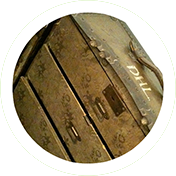Lawrence has five horses and twelve bottles of smuggled whisky to keep him company in the Lobo Mountains.
Keeping the Lawrence’s company in the Lobo Mountains were two French bulldog pups[i] and five horses[ii] that acted like ‘devils,[iii]’ refusing to be tamed. The horses were vital to their survival, enabling Lawrence to fetch milk and butter, and on one occasion, ’12 bottles of smuggled whisky.[iv]’
Horses are a recurring theme throughout his letters in June. The Hawks family, who owned the Del Monte Ranch, ‘had three horses struck by lightning[v]’ that month. In gifting the ranch to Frieda, Mabel Dodge Luhan now had nowhere for her own horses to graze, which was a source of irritation to her husband Tony. As tensions mounted, horses become a symbol for Lawrence’s deteriorating relationship with Mabel Dodge Luhan: ‘Instead of being all wild like the horses. We’ll all chew the cud of contemplation in our little corrals, then trot out for a reunion.[vi]’
Luhan had a chair made for Lawrence. In her memoir she proudly details its creation: ‘I carved it a little and cut up a fine old blanket to upholster it, with shining brass nails. It was intended to become Lawrence’s very own chair. I fancied him always sitting in it and always writing in it…one of those dedicated pieces of furniture that would slowly become associated with him.’
She fancied it. Lawrence didn’t. He was happier writing under a tree than in a grandiose piece of furniture clearly designed with posterity in mind. He subsequently nicknamed it the Iron Maiden after the infamous torture cabinet. Then Luhan made the cardinal mistake of forcing him to dance at a social gathering. He was seething.
Lawrence was mentally exhausted after his latest excursion in Europe which was soured by memories of the war which ‘changed me forever.[vii]’ He was also physically exhausted renovating the ranch, as this letter from the 4th June indicates: ‘I’ve done one of the hardest days work in my life today – cleaning the well. All the foul mud of the Thames – and stank like hell. Now it’s excavated and built in with stone, and the pipe sunk two feet deeper – Lord, this is the week we promised ourselves rest. I’ve still got to go to the Hawks’ for milk – and it’s 7pm. Wish we had a cow.’
The renovations meant he hadn’t written for awhile and instead was enjoying the natural rhythms of evening treks through the mountains with Frieda and Brett. ‘I don’t know why,’ he confessed to his mother-in-law ‘but words and speech have become a bit boring to me. We understand so well, without saying anything (…) Here, where one is alone with trees and mountains and chipmunks and desert, one gets something out of the air: something wild and untamed, cruel and proud, beautiful and sometimes evil, that really is America.[viii]’
To see previous video essays from 1924 see our playlist here. To read from the original source, see The Cambridge Edition of The Letters of D.H. Lawrence, Vol IV 1921 – 24 edited by Warren Roberts, James T. Boulton and Elizabeth Mansfield.
References
[i] Jerome and Alfred were the pups of Bibbles, Mabel Dodge Luhan’s French bulldog who lived with the Lawrence’s in the Winter of 1923.
[ii] The horses were called Contentos, Cequa, Poppy, Azul and Bessie.
[iii] Letter to Mabel Dodge Luhan, 4 June (L3137)
[iv] Letter to Thomas Seltzer, 23 June (L3194)
[v] Letter Thomas Seltzer, 19 June (L3147)
[vi] Letter to Mabel Dodge Luhan, 7 June (L3141)
[vii] Letter to Frederick Carter, 3 June 1924
[viii] Letter to Baroness Anna von Richthofen, 28 June (L3150)
